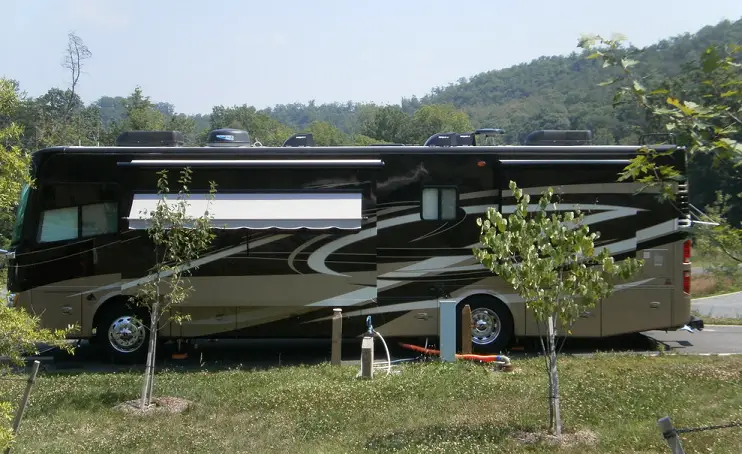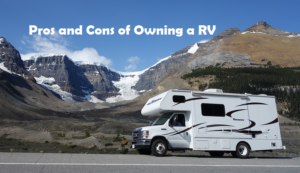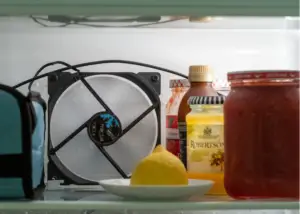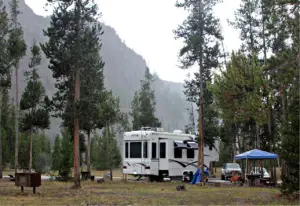An RV hookup is a type of utility connection that provides access to electricity, water, and sewer within an RV recreational trailer or campsite. Knowing how to install RV hookups is essential for enjoying the experience.
The cost of installing RV hookups vary depending on several different factors such as the location a campsite is in, the type of vehicle you’re using, and the actual installation itself.
RV hookups are necessary to create a functional camping space, that is a livable space with water, an ideal sewage system, and electricity.
Whether you are planning on hiring a professional to install your hookups or doing it yourself, there is a cost associated with it. However, if you install the hookups yourself, you will save money and time that you can use for other things, but it will depend on the intensity of your project.
So let’s discuss the cost of installing RV hooks and everything else you need to know.
Can you install an RV hookup at home?
What is an RV Hookup?
An RV hookup is a type of utility connection that provides access to electricity, water, and sewer within an RV recreational trailer or campsite. RV hookups are necessary for creating a functional camping space, which is a livable space with water, an ideal sewage system, and electricity.
RVs have several utility systems that require connection to municipal utilities to provide potable water, waste facilities, and electricity that are required for the RV’s operation.
It is very much possible to install an RV hookup at your home, it is not difficult to install as thought by many. Though you will need more time, effort, and money to do it. But if you are prepared for all these things then there is no reason why not to do it.
How much does it cost to install RV hookups?
The cost of installing an RV hookup entirely depends on whether you will be hiring a professional or you will be doing it yourself. The cost of hiring a professional is approximately $ 11,500 but if you do it yourself it will cost you about $500.
However, keep in mind that this is a labor-intensive project, which means that you need to have the proper tools and skills to do it alone.
In addition, you will need a permit and a permit can cost on average $50 for a municipal hookup or $150 for a residential hookup. If you hire a professional, everything is taken care of.
What Hook-ups do you want?
The kind of hook-up you want depends on the comfort of your home you want. A full hook-up site includes sewer, water, and electrical. If the RV is at your home or you are staying in place for your entire trip, a full hookup is an ideal setup.
Full-hookups are found at RV parks where the spaces are lined up side by side, giving you water and sewer service.
The advantages are that there are fewer challenges and you don’t have to make a lot of decisions or constantly monitor and dump your tank. However, full hook-ups are costly.
Then, there is an option of Electric and water-only hookup. This means you will have electricity and water only. You have the conveniences of water and electricity, but you have to drive to a dumpsite and empty your tanks. This setup is good if you do not have a lot of visitors.
Other options are Electric only or Water only hookups, but they are rare. Sites with only one hookup are common where you are camping on someone’s property/farm and they offer you an extension cord for electricity.
Types of RV Hookups
There are three types of RV hookups that are important when it comes to taking care of the essentials. However, there are a few more that are offered depending on the type of campground or your home.
RV Electric Hookup
An RV electrical Hookup is a utility connection that provides access to electricity and is used by the majority of vehicles. To connect the power, you need to have an RV electric hookup installed at your campsite or in your home.
Typically you need electricity in your RV to run your fridge, lights, air conditioning, televisions, pumps, water heaters, and any other electrical appliances.
The connections will vary depending on whether you are staying in a campground or at a home, but they are installed the same way. The electrical connection varies depending on the size and design of your RV.
The different levels of electric connections include 20 amp, 30 amp, and 50 amp. These variations determine the amount of power you can use when you are hooked up.
For instance, a 50 amp RV may use 600 to 800 watts, while a 20 amp RV may only use 200 watts. Some electric equipment such as fridges and air conditioners will use a lot of power, requiring a 50 amp connection.
A 50 amp connection has about three times the power of a 30-amp connection. When you purchase your RV, the company elaborates to you what you need and gives you the ideal cords for connection
RV Water Hookup
A water hookup connects you to reliable water which can be a public water system or to private well water. The connection is ideal for filling up your RV’s water tank and running an efficient sewage system.
The RV water hookup also connects you to the local sewer or septic systems when staying in a campground.
You must have a separate hose for fresh water. The hose is normally thicker than the regular hose and is BPA-free, lead-free, UV stabilized, and phthalate free.
A hose for fresh water is white. With this hose, you won’t see foreign things/objects in your water. Use this hose to connect to your drinking water and fill your fresh water tank.
RV Sewer Hookup
A sewer and septic system is an essential part of your RV because it will protect you from any bacteria or bacteria that might enter your RV. The RV sewer hookup connects you to the sewage system of your home or campground.
Your RV is equipped with three tanks. Apart from the fresh water tank, there is a black water tank and a gray water tank.
The gray water tank collects water from your shower and your sink. This water is dirty, but it is not sewage. The black tank collects your toilet content.
Some RV sites are designed with sewage hookups to hook up directly at the site. Therefore, you will just use a sewage hose to connect the black tank directly to the sewage outlet.
If the campsite does not have a sewer hookup, you will have to access a public dump site. If you are staying in your home, you will need to install a septic tank to dispose of the toilet content.
Ensure you store your sewer connections separately since they are covered with sewage. Your health is important, so you should isolate the connections to prevent infections.
DIY Hook-up Installation at Home
If you want to save money, you can install the RV hookups by yourself. The main challenge is that you need basic tools and a lot of time. We have provided a step-by-step DIY guide to give you an idea of how to get it done by yourself.
Step 1: Create a parking pad
The goal is to be able to drive your RV on it. The pad should be level, flat, and large enough to park your RV on it. You will need to remove the sod or grass in your yard and then create a driveway with a gravel base to place your RV.
The pad should be at least 4 feet wide while the length should be enough to park your RV on it.
Step 2: Install a post
When your pad is in place, dig a hole to put a 4-inch diameter post to hold your water and electric hookups so that it does not move when you hook up. The post should be on the driver’s side of your RV.
Step 3: Install your water hookup
The water hookup is a large pipe that you connect to your RV. This will be the outside tap that you will use to fill up the water tank.
To install the outside tap, dig a hole 2 feet wide and 2 feet deep or deeper. Place a 1-1/2 inch diameter pipe into the hole with 1- foot of space between the ground and the pipe.
Fill up this gap with concrete to ensure that it will not move. After you have finished, you can either fix the water tap or leave it open.
Step 4: Install your Electric Hookup
For this step, it is recommended to hire a professional. Whoever installs this hookup needs to make sure it is watertight. The electric hookup should be installed in a way that it is on the exterior of your RV and not under the vehicle.
Additionally, the electrician should know the type of plug your RV uses; a 20 amp, 30amp, or 50 amp. The electrician should be able to accurately measure the current needs of your RV.
Step 5: Install your Sewer Hookup
The sewer hookup is the pipe that you will connect to the sewage outlet of your home or campsite. In some states, a septic system is not required. However, it is recommended to install a septic system for better and safer sanitation.
The septic system contains a leach field, a drain field, and drain pipes. First, you need to excavate a hole about 3 feet deep and 3 feet wide. Then you should cover the bottom of the hole with gravel.
Next, install a plastic pipe with a bottom cap and then pour in 1 foot of gravel on top. Finally, you need to install the drain pipes and lay the drain field.
- Why install RV Hookups?
Most camping spots have installed RV hookups for electricity, water, and sewerage. However, they are a bit expensive. So, installing your RV hookups at home or your camping site is cheaper.
By installing your RV hookups, you will save money, and time and also you will have control of the placement.
- How do you tell the difference between different amp options?
50-amp plug-ins come with 3 flat prongs and a round prong. The 30-amp plug-ins have one round prong and 2 flat angled prongs, while the 20-amp plug-ins have one round prong and two straight plat prongs.
- What else do you need to buy after installing RV hookups
After you have installed the RV hookups at your home, you will need to buy other accessories. Some of the accessories are as follows: A cooler, running water, a shower unit, and an air conditioner.
You will also need to buy a water hose, sewer hose, and an RV washing machine. It is recommended to have at least 2 feet of headroom when you are planning on installing the hookups.
4. Can you Hookup an RV to house power?
It is possible to hookup an RV to house power, but just for a short time. This idea is not recommended since it could lead to an electric problem in your house.
Moreover, chances are that your RV will not be able to power the house (since it will draw too much power). So, it is recommended to have a generator handy in case there is an emergency and the power goes out.
5. How To Plug an RV Into Your Home’s Power
If you need to plug your RV into your home, you will need several items. First, you have to purchase a 30-amp adapter cord and a 30-amp pigtail cord.
To complete this you will need a 10-foot male extension cord, 15-25 feet cable, and an RV power inlet box. Once you have all of the items, you can easily attach them and then plug in your RV.
When carrying out these steps, ensure your electricity is switched off to prevent any accidents.
Conclusion
If you are just thinking of buying an RV, there is no better way than to get the hookups. Not only will you save on your traveling expenses, but you will also be able to hook up every night and enjoy your surroundings.
The cost of RV hookups varies depending on the design and size of your trailer as well as the type of hookup you need. If you are on a budget you can opt to install the hookups by yourself.




